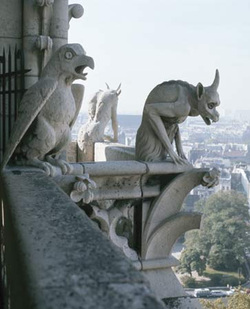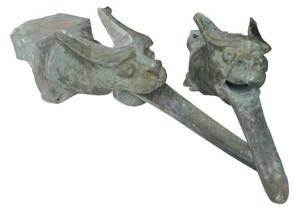Gargoyles are commonly found on Medieval architecture such as castles and roofs. They are also found on old Medieval cathedrals and churches. The word "Gargoyle" comes from the French word "Gargouille", which means throat or gullet.
Gargoyles

Origin: There are many legends behind the creation of gargoyles. One includes the fact that gargoyles were meant to ward of the devil. Other people, however, believe that they were intended to remind them of the perils of evil. The most interesting story contains a dragon and a priest. The priest's name was Romanus, and he was forced to care for a dragon named La Gargouille. He gained this job by persuading the villagers to be baptized in the River Seine. The priest led the villagers to the river and baptized them, also keeping the dragon in a cave. La Gargouille was condemned to be burned at the stake in the town shortly after. His head and neck, unlike his other body parts, were unable to give way to the roaring fire. The remnants of La Gargouille were mounted on the town's wall, creating the first true gargoyle.
Description: Gargoyles are often gruesome stone carvings that sit atop roofs and buildings. They were at one time drains that were on top of Medieval cathedrals before they were carved into their present description. Gargoyles are mixtures of many animals that have been combined together as one, known as chimeras.
Connection to Medieval Life: Gargoyles were seen on many Medieval buildings and monuments. They were sometimes used as water spouts along with their place as statues. A Medieval building wasn't authentic without a stone gargoyle!
Description: Gargoyles are often gruesome stone carvings that sit atop roofs and buildings. They were at one time drains that were on top of Medieval cathedrals before they were carved into their present description. Gargoyles are mixtures of many animals that have been combined together as one, known as chimeras.
Connection to Medieval Life: Gargoyles were seen on many Medieval buildings and monuments. They were sometimes used as water spouts along with their place as statues. A Medieval building wasn't authentic without a stone gargoyle!

